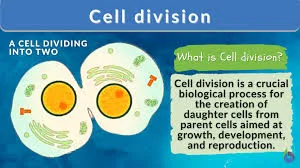Cell Division
-
Definition of Cell Division
- Cell division is the process by which a parent cell divides into two or more daughter cells.
- It is essential for growth, development, reproduction, and tissue repair in living organisms.
-
Types of Cell Division
- Mitosis: Produces two genetically identical daughter cells; occurs in somatic (body) cells.
- Meiosis: Produces four genetically diverse daughter cells with half the chromosome number; occurs in gametes (sex cells).
Illustration:
- Mitosis: 2n → 2n + 2n (Diploid to diploid)
- Meiosis: 2n → n + n + n + n (Diploid to haploid)
-
Stages of Mitosis
- Prophase: Chromosomes condense, nuclear envelope breaks down, spindle fibers form.
- Metaphase: Chromosomes align at the cell’s equator, attached to spindle fibers.
- Anaphase: Sister chromatids separate and move to opposite poles.
- Telophase: Nuclear membranes reform, chromosomes de-condense, and the cell begins to split.
- Cytokinesis: The cytoplasm divides, forming two daughter cells.
-
Importance of Mitosis to Life
- Growth and development of organisms.
- Repair and replacement of damaged or dead cells.
- Asexual reproduction in some organisms.
- Maintenance of genetic stability by producing identical cells.
-
Biological Processes Involving Mitosis
- Growth in multicellular organisms.
- Wound healing and tissue repair.
- Regeneration of body parts in some organisms (e.g., starfish).
- Replacement of old or dead cells (e.g., skin and blood cells).
- Asexual reproduction in organisms like bacteria and hydra.
MieosisSumm
Meiosis is a type of cell division that reduces the chromosome number by half, producing four genetically unique haploid cells. It occurs in two stages:
-
Meiosis I (Reduction Division)
- Prophase I: Homologous chromosomes pair up and exchange genetic material (crossing over).
- Metaphase I: Homologous chromosome pairs align at the equator.
- Anaphase I: Homologous chromosomes separate, reducing chromosome number.
- Telophase I & Cytokinesis: Two haploid cells form.
-
Meiosis II (Equational Division)
- Prophase II: Chromosomes condense again.
- Metaphase II: Chromosomes align individually at the equator.
- Anaphase II: Sister chromatids separate.
- Telophase II & Cytokinesis: Four genetically diverse haploid cells are produced.
Importance of Meiosis
- Ensures genetic diversity through crossing over and independent assortment.
- Produces gametes (sperm and egg) for sexual reproduction.
- Maintains chromosome number across generations.
-
Meiosis I (Reduction Division)
- Prophase I: Homologous chromosomes pair up and exchange genetic material (crossing over).
- Metaphase I: Homologous chromosome pairs align at the equator.
- Anaphase I: Homologous chromosomes separate, reducing chromosome number.
- Telophase I & Cytokinesis: Two haploid cells form.
-
Meiosis II (Equational Division)
- Prophase II: Chromosomes condense again.
- Metaphase II: Chromosomes align individually at the equator.
- Anaphase II: Sister chromatids separate.
- Telophase II & Cytokinesis: Four genetically diverse haploid cells are produced.
Importance of Meiosis
- Ensures genetic diversity through crossing over and independent assortment.
- Produces gametes (sperm and egg) for sexual reproduction.
- Maintains chromosome number across generations.
-
Differences Between Mitosis and Meiosis
Feature Mitosis Meiosis Definition Cell division that produces two genetically identical daughter cells. Cell division that produces four genetically diverse daughter cells. Location Occurs in somatic (body) cells. Occurs in reproductive (germ) cells. Purpose Growth, repair, and asexual reproduction. Sexual reproduction and genetic variation. Number of Divisions One cell division. Two consecutive cell divisions (Meiosis I and Meiosis II). Number of Daughter Cells Two daughter cells. Four daughter cells. Chromosome Number Daughter cells have the same number of chromosomes as the parent cell (Diploid, 2n → 2n). Daughter cells have half the chromosome number of the parent cell (Diploid, 2n → Haploid, n). Genetic Variation No genetic variation; daughter cells are identical to parent cells. Genetic variation occurs due to crossing over and independent assortment. Crossing Over Does not occur. Occurs during Prophase I, leading to genetic recombination. Examples Skin cell division, wound healing, and asexual reproduction. Formation of gametes (sperm and egg cells) in animals, pollen and ovule formation in plants.







Comments